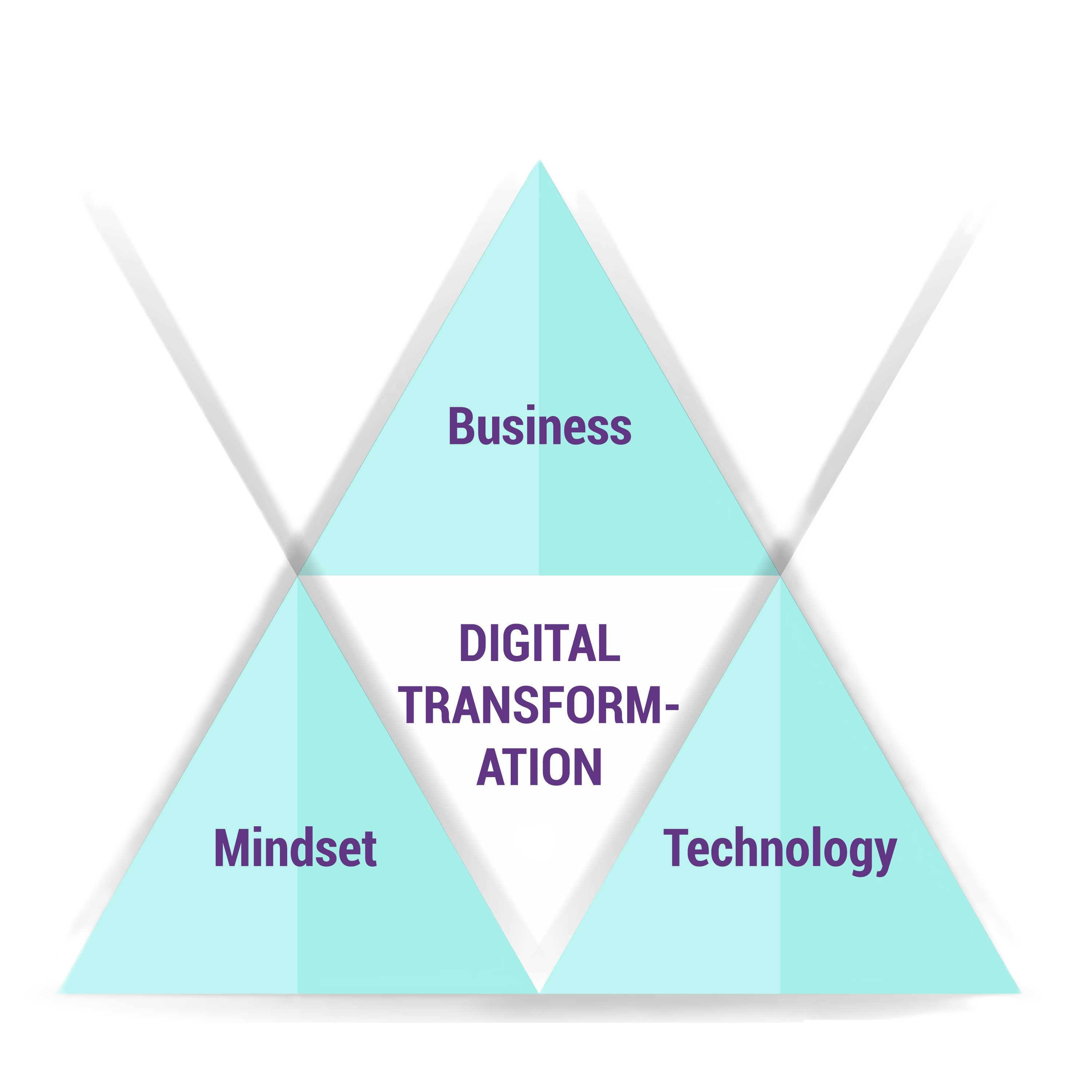Digital Process Transformation
News flash: Digital organizations are here to stay. If you aren’t embracing digital by digitizing business processes in your organization, get ready to be disrupted.
Digitization inherently involves business innovation that creates new opportunities for innovating customer experiences, streamlining processes, and building new business models.
You might already have a pretty good idea of what a digital organization should look like. Maybe you even think of yourself as the leader of a digital organization, or maybe you’re still struggling to “Keep up with the Joneses” as digital-first startups run circles around your business or organization.
But what does a truly digital organization look like?
Truth be told, most business leaders don’t know what a digital organization should or shouldn’t look like. That’s because there isn’t one solid definition. In fact, the use of words and phrases like Digitization, Digitalization, and Digital Transformation have been applied and misapplied interchangeably for years, with few people paying enough attention to grasp exactly what the difference is between them.
Most organizations rely heavily on digital systems and solutions these days, both to streamline internal processes and improve external customer experiences. If you’re not adapting your business model to digital processes or putting new digital products in front of customers that engage and delight them, chances are your customers will leave you for someone who does.
We are entering a New Era: the Era of the Digital Organization. Businesses will be faced with challenges unlike ever before, and they will also have the opportunity to grow and reap rewards beyond their wildest dreams. What follows is an overview of the pathway towards growing a truly digital organization.

Defining Digitization, Digitalization, and Digital Transformation
We’ll say it: digitization has become somewhat of a buzzword. So has digitalization. Don’t even get us started on the phrase digital transformation. These words and phrases are often used interchangeably and, frustratingly, incorrectly. While each has their place in current business terminology, the important thing is to understand the subtle differences between these words in order to understand how each can affect the business processes of an organization.
Digitization
Digitization is simple. According to the Oxford English Dictionary, digitization is “the conversion of text, pictures, or sound into a digital form that can be processed by a computer.”
The purpose of digitization is to turn something that is “paper-based” or analog (if you remember what that means) into digital format, code, or data that can be read and processed by a computer. Digitization makes it easier to share data and recognize patterns in large amounts of information. It can affect the core processes and systems of any business, from logistics and supply chain processes to customer insights and finance.
Digitalization
While digitization and digitalization sound similar, they are quite distinct. Digitization is focused on converting physical things into digital format (i.e. pictures, books, audio, video, etc.). Digitalization is much broader in scope. It is the process through which a company uses digital tools, technology and ecosystems to provide greater value for customers and clients usually through new customer experiences, solutions and business models.
According to Gartner, digitalization is “the use of digital technologies to change a business model and provide new revenue and value-producing opportunities.” Digitalization happens every time a business uses digital tools & services to reach their audience in a different way. It happens every time they develop a new product which provides greater value to a customer. And it happens every time a business adopts a new technology which lets them be better than the competition using digital technology. Digitalization happens just about any time a product or service changes (because of technology) in a way that the customer experience or interaction model is restructured around digital communication and media infrastructures.
Digital Transformation
Digital transformation encompasses both digitization and digitalization. It is not the process of converting a businesses’ files from paper to digital format. Nor is it launching a single initiative to create a new way of processing product complaints through a company’s website, for example. Digital transformation is the amalgamation of multiple initiatives, projects and processes to bring an organization from a nascent state of digital competence to a mature state of true digital capability.
What’s more, digital transformation keeps the customer at the center of all decision-making and strategies. Businesses that attempt to bring about digital transformation with the intention of providing more value to customers will be the best suited to succeed.
Digital Organizations & Transformation
It has never been easier to start a massively successful business using just your laptop or computer. Billion-dollar companies are born out of the minds of entrepreneurs in the space of a few months. All the next Zuckerberg needs is an idea and some programming skills to raise a few million in funding from the nearest VC. It all seems easy as pie.
But it also has never been so easy to fail. Customers demand more from businesses than ever before. They demand seamless shopping experiences, unparalleled customer service, rapid delivery, and instantaneous recommendations.
The average consumer has become digitally spoiled. Companies like Airbnb, Amazon, Uber and Apple have elevated our expectations around what it means to receive good service. These companies pour millions of dollars annually into digital programs to ensure their customers are kept happy, and they keep tabs on them using digital tools which ensure they are always just the touch of a button away.
These same consumer expectations are now also leaping into the workplace. With the rise of consumer expectations come increasing demands on businesses to provide their employees with seamless processes for managing business processes that enable knowledge workers to do their jobs more effectively or efficiently.
The challenge is this: How do businesses adapt and anticipate changing technological and cultural pressures from customers and employees? With digital tools and technologies disrupting the balance and raising expectations of all stakeholders, what can business leaders do to stay ahead and continue to innovate?
Digital Organizations as the Future
In order to adapt to shifting customer expectations, it is essential that businesses adopt the digital organization mindset. But what exactly is the digital organization mindset?
The digital organization mindset is a way of thinking about problem-solving and value-creation through a digital-first lens, always maintaining a focus on the end customer. They continually look for ways to delight your customer by going above and beyond their expectations by implementing digital solutions.
The benefits and implications of implementing digitization, digitalization, and digital transformation across a business are huge. A few areas where going digital can drive benefits for your organization include:
- Enabling faster decision making
- Allowing seamless performance tracking
- Generating deeper customer insights
- Creating more compelling customer experiences
- Automating manual tasks
- Innovating new products, services and business models
On top of these, reducing physical and manual processes with software allows businesses to collect ongoing data to better understand work flows, flag cost drivers and identify risk areas so they can be acted on quickly and efficiently before they become major issues. On top of this, real-time digital dashboard reporting empowers managers to make speedy decisions before problems get out of hand through predictive analytics and even artificial intelligence.
Complete digital transformation may seem like a lofty goal but consider the implications of not acting. Businesses that don’t undergo digital transformation are bound to be hit with even more disruption in the years ahead, and those who aren’t able to adapt quickly to changes in technology and ways of working will be at a huge disadvantage compared to the competition.
A complete digital overhaul of a business requires a company to consider every business process within the organization to see what can be digitized, what can’t, and what should be reconceived entirely (see: digitalization) to develop a new digital-first system or process which will better serve the customer. It doesn’t have to be disruptive to the current business however, since many of these activities can be staged over time in a “digital transformation roadmap”.
Changing processes to a digital format can indeed be challenging. There are several approaches that can be used to help guide change agents on the path towards full digital business process transformation:
7 Steps to Digital Transformation
Scalable and relevant internal and external business processes are the foundation of any successful organization. A business process is a collection of tasks conducted by employees, customers, partners or other stakeholders in a specific order to reach a certain end business objective.
Internal processes may be required to develop or deliver a product or service. External processes may be related to providing a customer with the best service & delivery in a timely manner.
Step 1: Define Success
For each process you are looking to digitize, develop a clear framework for identifying the objective and related success measures. Define your specific objectives and keep your end goal in mind. Some call this the definition of Objectives and Key Results (OKRs), but you can call it what you like. The key here is to develop that high level (yet specific) objective and the quantitative metrics (like time savings, cost savings, increased customer satisfaction, etc.) that will help you reach a desired result.
Step 2: Scope Processes
Determine what type of business process you want to digitize. There tend to be three main types of business processes: operational, managerial, and supporting. Operational processes are core processes that are required to build, develop, and deliver products and services to customers. Managerial processes are systems which track and oversee budgets as well as strategic growth opportunities. Supporting processes are the systems that are in place on the back end of any business, like technical support, office administration, and customer complaints handling. Understanding the relevant type of process for digitization helps determine which stakeholders to involve, what best practices should be reviewed and what benchmarks to use.
Step 3: Define your Digital Business Model
Depending on what you want to achieve, you need to choose a digital business model that enables you to grow and scale effectively. The best way to define your digital business model is to think about how different digital platforms enable businesses to innovate and take advantage of emerging trends while staying ahead of the competition. While digital processes and systems enable businesses to operate more efficiently, deliver products and services more quickly, and ultimately provide a better experience to the end consumer, processes aren’t the same as business models.
Digital Business Models allow organizations to leverage technology to address customer needs in unique ways that create competitive differentiation and that create financial sustainability. There is no single right or wrong digital business model, but the model that you choose to pursue will have a big impact on the future potential of the business. The more thought you put into developing a digital business model that resonates with your customers and team, the better positioned you will be to make the most of digital opportunities.
For example, it’s normal for startups these days to pitch their businesses by saying:
“We’re creating the Netflix of X.”
“We’re building the Uber of Y.”
“We’re going to be the Amazon of Z.”
The reason these businesses are mentioned so often is because they represent the cream of the crop when it comes to digital business model innovation. They created entirely new solutions and customer experiences that changed the game and disrupted the previous business model. And they not only disrupted their own industries, they threaten to disrupt others as well. One of the most important reasons to adopt digital business model innovation is to ensure you don’t get disrupted yourself. When you choose to develop a digital business model, it becomes easier to pivot and to change direction when competitors enter your arena.

Step 4: Reinvent & Streamline (as needed)
Business processes should be looked at holistically before simply converting them from analog to digital. Move beyond automating existing processes and start to create or reinvent your own processes as necessary. There is more to developing a digital organization than automating what once was a manual process. Look for opportunities to tweak or adjust processes, reinventing them or streamlining them in ways that boost operational efficiency, improve data gathering or speed up decision making (to name a few use cases).
Step 5: Leverage No-Code Software Platforms
Digital transformation always includes some type of software. Most larger organizations rely on enterprise software solutions to help them operate their businesses and conduct every task imaginable, from marketing and sales to operations and financial management. According to Gartner, the enterprise software market is expected to be worth approximately $634 billion by the end of 2023.
The big trend that will dramatically accelerate digital transformation is no-code software. Why? No-code software allows anyone to define and scale a business process without coding knowledge. It’s “democratizing” software so that custom solutions become accessible to anyone, not just high-priced consultants and programmers. Is is estimated that 65% of all software app development will be done using low-code or no-code software applications. Forrester estimates that low-code software platforms will represent $21 billion in spending by 2022.
No-Code software is usually sold as a Software as a Service (SaaS) and allows users to:
- Drive innovation and new product development
- Improve customer experiences
- Streamline business processes and operations
- Support analysis, reporting, and oversight
- Enable external partner collaboration and sharing
- And just about any other process
Understanding the implications of no-code software will be important no matter what industry you’re in. You no longer need to be an expert in software development to leverage technology.
Step 6: Create a Digital Transformation Roadmap
A Digital Transformation Roadmap is a clear visual representation, sequenced over time, of the major digital strategic goals of the organization. A roadmap is useful for communicating the digital strategy in a simple way to employees and stakeholders across the organization. In this way, everyone can see how digital technologies and processes support the company’s existing goals and will help achieve and advance its vision and mission. As a strategic tool, a Digital Transformation Roadmap outlines the specific actions that should be implemented over time to create new processes, customer experiences or business models.
Step 7: Stay Lean and Data Driven
Work using lean approaches versus long projects with high-risk “go live” dates. Continuous development, iteration and rapid releases are now the name of the game. The “Lean” movement which include books and articles on various lean processes have extolled the power of the huddle group, agile product development and customer centric design. Take this to heart and develop solutions which can be tested and put in front of colleagues or clients as quickly as possible to iterate on digital solutions.
The best way to make sure you stay true to each of the pillars of business process digitization is to be unreasonable in your expectations and aspirations. Dream big and look to fully transform your business by adopting digital business processes that fit the needs of your market and target audience but that are feasible through “start small and iterate” approaches (e.g., start with the skate board and build to the Ferrari).
If you’re already digital, get more of it. If you’re just starting out, find a quick win and build from there. Every transformation starts with a single step.


